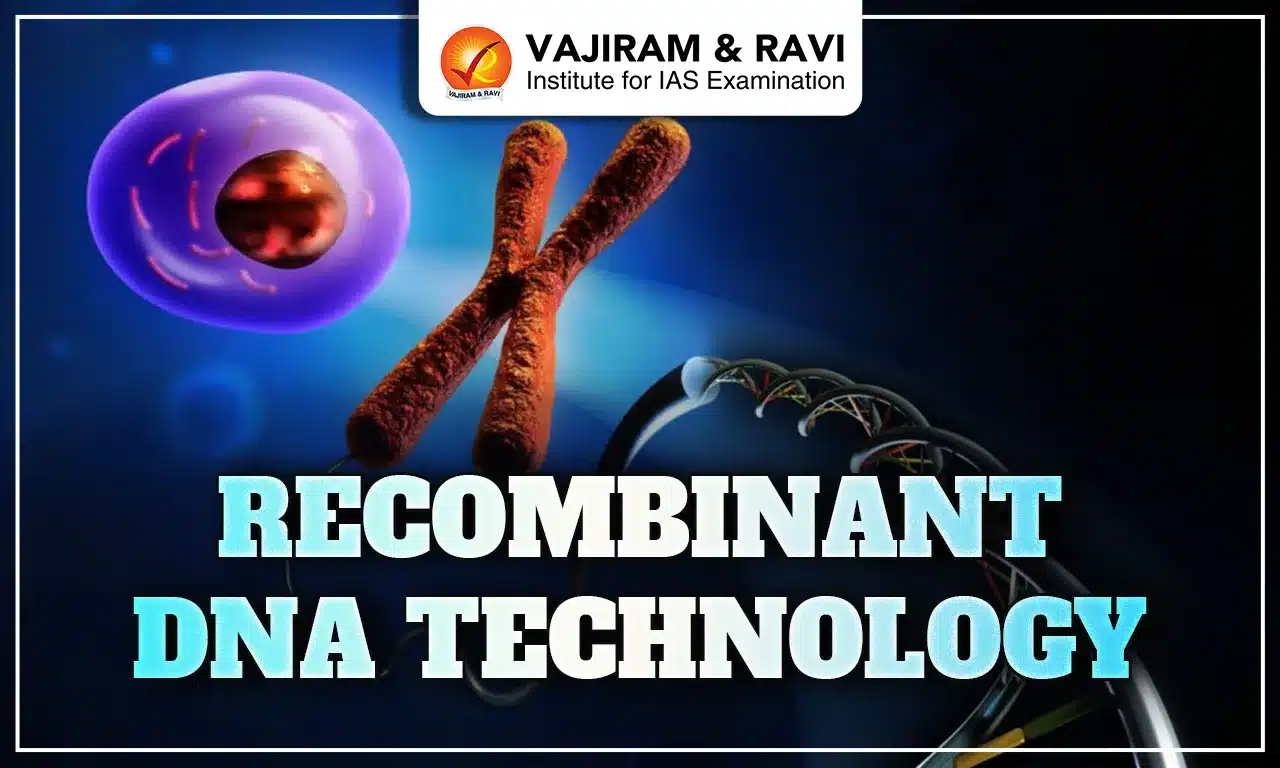Recombinant DNA technology (RDT), often referred to as Genetic Engineering, is an in-vitro (lab) method of manipulating genes (DNA fragments) by using a set of tools and techniques. The primary aim of RDT is to produce “Transgene (recombinant DNA) and its product (recombinant protein), to be applied across different fields of biotechnology.
The RDT is a continuously evolving technology due to the advancement in its tools and techniques, such as the discovery of the CRISPR-Cas9 gene editing tool.
Tools of Recombinant DNA Technology
The following are the tools employed in the process involved in Recombinant DNA Technology:
| Tools | Utility | Examples |
| Vector | They are used as carriers to introduce foreign DNA into a host cell |
- Plasmids (for example, pBR322, Ti Plasmid), - YAC (Yeast Artificial Chromosomes), - BAC (Bacterial Artificial Chromosomes), - Viruses (Phages), etc. |
| Restriction Enzymes | It recognises specific DNA sequences and cleaves the DNA at the precise location |
- EcoRI, HindIII, BamHI, etc - CRISPR Cas9 ( used primarily nowadays) - Zinc-Finger Nuclease (ZFN) |
| DNA Ligase | It joins together DNA fragments | - T4 DNA Ligase |
| Selectable markers | To distinguish transformed cells from non-transformed ones | - Antibiotic resistance genes, herbicide resistance genes, etc |
Process involved in Recombinant DNA Technology
Recombinant DNA technology undergoes through the following steps:
- Isolation of Genetic Material: The extraction of genetic material is performed from the source organism’s DNA, such as bacteria, plants, or animals.
- Selection of a Suitable Cloning Vector: Vectors are carrier molecules used to introduce rDNA into a host organism.
- Plasmids, which are small, circular DNA molecules, are commonly used vectors. They can replicate independently within a host cell, allowing for the propagation of the foreign DNA.
- The vectors can also be non-self replicating (for example, viral vectors).
- Cutting of DNA at Specific Locations: It uses the specialized enzymes known as restriction endonucleases (RE) or restriction enzymes, which recognize specific DNA sequences (recognition sites) and cleave the DNA at those precise locations.
- The RE cuts the target DNA as well as Plasmid, producing "sticky ends" that are complementary to each other.
- Joining of DNA Fragments by Ligation:
- The isolated DNA fragments are combined with a vector, which is typically a plasmid or a viral genome modified to accept foreign DNA.
- DNA ligase is used to catalyze the formation of phosphodiester bonds, effectively sealing the gaps and fusing the DNA fragments with the vector.
- Now the rDNA is ready for gene transfer (for in-vivo gene cloning) or for the PCR.
- Gene Transfer: There are several methods which are employed in the process of Gene Transfer- physical, chemical, and biological. RDT uses the biological means of gene transfer.
- Physical methods: Gene gun or Biolistics, Electroporation, Microinjection, etc., which make the direct entry of the rDNA into the host’s cell.
- Chemical methods: Using Lipofection, calcium phosphate, etc. make it easier for the rDNA to enter into the host’s cell.
- Biological methods: This is an indirect method of gene transfer, using vectors (for example, bacteria) as a means.
- Gene Cloning: Once inside the host, the rDNA replicates itself independently (due to self-replicating plasmid). This is called Gene Cloning. It can also be done using the PCRmethod for amplifying a gene of interest.
- Polymerase Chain Reaction (PCR): PCR is a tool that allows for the amplification of the target DNA sequences outside the cell. It needs much less time than the traditional cloning methods.
- Selection and Screening of Transformed Cells: This step involves identifying and isolating cells that have successfully taken up the recombinant DNA.
- Selectable markers, such as antibiotic resistance genes carried by the vector, are often used to distinguish transformed cells from non-transformed ones.
- Validation of Recombinant DNA Integration: To ensure that the recombinant DNA has integrated into the host genome as intended, various techniques may be employed.
- For example, nucleic acid hybridization, blue-white screening, etc.
Applications of Recombinant DNA Technology
Recombinant DNA Technology stands as a cornerstone of modern science with far-reaching applications across numerous fields.
- Advancement in Medicine:
- It enables the production of vital biopharmaceuticals, particularly therapeutic proteins like insulin, growth hormone, and clotting factors.
- Customized Therapeutics enables the production of personalised medicines tailored to an individual's genetic makeup, leading to more effective and targeted treatments.
- Gene Therapy:
- It offers the potential to treat genetic disorders by replacing or repairing faulty genes.
- It is helpful in treating a wide range of diseases, like cystic fibrosis, muscular dystrophy, and certain types of cancer.
- Recombinant Vaccines: RDT can be used to develop vaccines for a variety of diseases, using vectors like bacteria, yeasts, viruses (phage), etc.
- Immunotherapy: RDT contributes to the development of immunotherapies for example, T-cell therapy, which harnesses the body's own immune system to target and destroy cancer cells.
- Agricultural Advancements:
- It is used to cultivate Genetically modified (GM) crops that have transformed agriculture. Example: BT cotton.
- These crops possess traits like pest resistance, drought tolerance, and improved nutritional content.
- Bioremediation and Environmental Protection:
- Environmental biotechnology indicates that Genetically-modified microbes such as bacteria, yeast and filamentous fungi can remove heavy metals from aqueous solutions.
- For example, Escherichia coli strain JM109 has the ability to remove mercury from contaminated water or soil.
- Targeted Drug Delivery:
- It enables the design and production of drug-delivery systems that can precisely target specific tissues or cells within the body.
- This increases the effectiveness of treatments while minimizing side effects.
- Molecular diagnosis (RDT plus PCR):
- It plays a critical role in diagnostic techniques, allowing for the detection of specific DNA sequences associated with diseases or pathogens.
- It is helpful in early detection and monitoring of various conditions.
- Industrial Applications:
- It is used in the production of recombinant enzymes to produce sugar, cheese, biofuels, important chemicals, etc.
Last updated on November, 2025
→ Check out the latest UPSC Syllabus 2026 here.
→ Join Vajiram & Ravi’s Interview Guidance Programme for expert help to crack your final UPSC stage.
→ UPSC Mains Result 2025 is now out.
→ UPSC Notification 2026 is scheduled to be released on January 14, 2026.
→ UPSC Calendar 2026 is released on 15th May, 2025.
→ The UPSC Vacancy 2025 were released 1129, out of which 979 were for UPSC CSE and remaining 150 are for UPSC IFoS.
→ UPSC Prelims 2026 will be conducted on 24th May, 2026 & UPSC Mains 2026 will be conducted on 21st August 2026.
→ The UPSC Selection Process is of 3 stages-Prelims, Mains and Interview.
→ UPSC Result 2024 is released with latest UPSC Marksheet 2024. Check Now!
→ UPSC Prelims Result 2025 is out now for the CSE held on 25 May 2025.
→ UPSC Toppers List 2024 is released now. Shakti Dubey is UPSC AIR 1 2024 Topper.
→ UPSC Prelims Question Paper 2025 and Unofficial Prelims Answer Key 2025 are available now.
→ UPSC Mains Question Paper 2025 is out for Essay, GS 1, 2, 3 & GS 4.
→ UPSC Mains Indian Language Question Paper 2025 is now out.
→ UPSC Mains Optional Question Paper 2025 is now out.
→ Also check Best IAS Coaching in Delhi
Recombinant DNA Technology FAQs
Q1. What is Recombinant DNA Technology?+
Q2. What are the steps in Recombinant DNA Technology?+
Q3. What are the different types of recombinant DNA?+
Q4. Why are bacteria used in recombinant DNA technology?+
Q5. What are the benefits of recombinant DNA technology?+



















